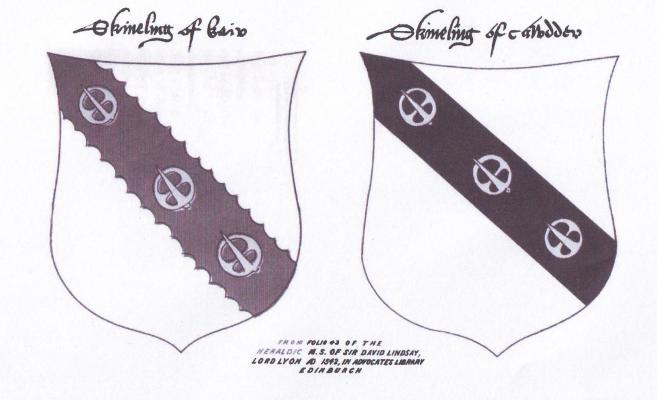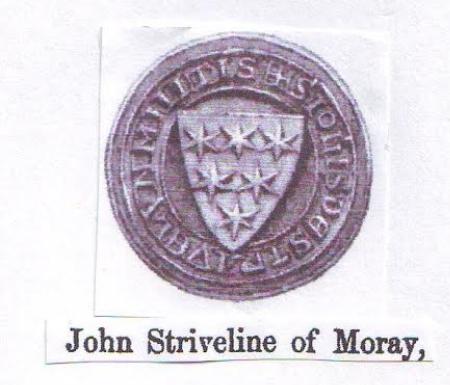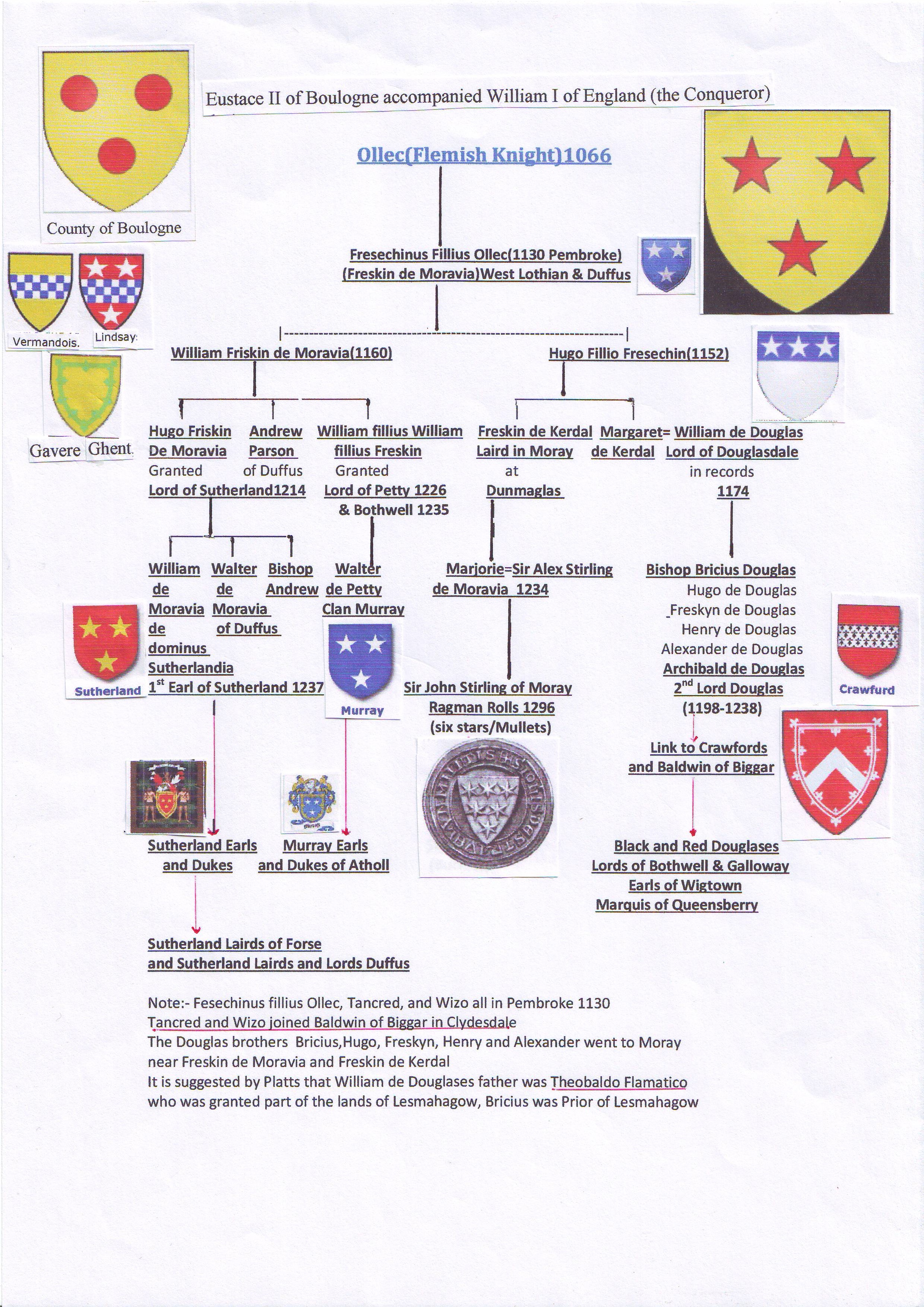The Barony of Kerdale and its Links with some Key Moray Families
Freskyn de Moravia, believed to be a Fleming, was the progenitor of two major Scottish families: the Sutherlands and the Murrays. Freskyn de Kerdale and his sister Margaret were directly descended from Freskyn de Moravia down a separate line. Through marriage there were close links between this line and the Douglas and Stirling families. In this blog posting that builds on an earlier one dated 21st of November 2014, James Sutherland and Mark Sutherland-Fisher report on their research on the Barony of Kerdale and these family linkages.
Freskyn de Moravia (Fresechinus fillius Ollec), who was believed to be a Fleming, was influential in Scotland during the early medieval period. New information discovered recently shows that Freskyn had settled initially in Pembroke in Wales with other Flemings, including Witsonis Flandrensis.[1] He later accompanied King David I to Scotland and was given lands in Strathbroc, West Lothian. Subsequently he helped put down an insurrection in 1130 in Moray. He was given lands in Duffus and built a fortress there.
The De Moravia family has genealogical significance for Scotland. The senior line of the family became Earls of Sutherland. A separate branch of that line contains the important Murray Earls and Dukes of Atholl. See the genealogical diagram below. Along a separate line arose the De Kerdale family, which developed links with two other significant Scottish families, Stirling and Douglas. Both of these families are believed to have Flemish roots. These family linkages are the subjects of this blog posting.
The Stivelyn or Stirling family was settled at an early date in the neighbourhood of Dunmaglas in Strathnairn in the north of Scotland (see map below). By 1234 Sir Alexander Stirling of Moray had married Marjorie de Moravia, daughter of Freskyn de Kerdale, who, as noted above, was descended from Freskyn de Moravia.
The Stirling family is one of great antiquity, having been descended from Walter de Strivelyn, who appears as a witness in a charter of Prince Henry, son of King David I of Scotland, of a grant of the church of Sprouston by John Bishop of Glasgow to the Abbey of Kelso in 1144.[2]
Freskyn de Kerdale was a patron of the church at Daviot, which was the mensal church of Bishop Bricius de Douglas, son of William de Douglas Lord of Douglasdale. At the insistence of Freskyn de Kerdale the tithes of Daviot were granted for the fabric of the Cathedral Church at Spynie, which is situated a little to the north of Elgin.[3] Hence Freskyn de Kerdale was supportive of the bishop, and therefore also the Douglas family.
When Bricius died in 1223 his successor Andrew de Moravia confirmed the previous grant, and in 1234 land at Daviot was subject to an agreement between the chaplain of Moray and Sir Alexander Stirling of Moray. Freskyn de Kerdale was avuncular noster (our uncle) to Bishop Brice. In other words, Freskyn de Kerdale was related to Bishop Bricius and his brothers.
The De Moravia family also held Petty and the lands of Croy, Kilravock and Cantray, which were distributed as marriage portions to the daughters of the family. All that remains now of the association between the De Moravia family and the area is Cantray-Freskyn. Marjorie de Moravia, widow of Sir Alexander Stirling, granted to her daughter, Isobel, the lands of Cantray-Freskin. The witness was Archibald, Bishop of Moray, who held his see during the period 1253-1258. The Murrays of Petty male line ended in a daughter, Joan, who married Lord Archibald Douglas (Archibald the Grim), Lord of Galloway, Lord of Bothwell, and Earl of Wigtown, who became 3rd Earl of Douglas.
There are several pieces of evidence to suggest a presence of the Kerdale family in Scotland some two centuries later. A James of Kerdale witnessed a charter granted at Castle Urquhart in 1342, and a Nicholissa of Kerdale in 1414 was one of the superiors of Dunmaglas in the Barony of Kerdale, which was held by Donald, Thane of Cawdor.[4]
Interestingly, the Macgillvrays of Dunmaglas were the first clan to join the Confederacy of Clan Chattan (the Confederacy allowed greater protection for its constituent clans). Petty was the original home of the Mackintoshes, chiefs of Clan Chattan. In early history the Macintoshes were Tosheachs or Chamberlains of Petty.[5]
Recent research by this author on the family tree of the Douglas/Hamilton family shows William de Douglas as being married to a sister of Freskyn de Kerdale, Margaret de Kerdale. They had six sons: Brice de Douglas, Alexander de Douglas, Archibald Lord Douglas, Henry de Douglas, Hugh de Douglas, and Freskyn de Douglas.
After its forfeiture by Archibald Douglas, Earl of Moray, in 1455, the land of Strathnairn was for some time in the hands of the crown. Then it was owned by the Ogilvies of Banff and later was sold to Sir John Campbell of Cawdor in about 1535.
Archibald Douglas, the eldest son of William de Douglas, possessed Hailes in Midlothian (before 1198). This was close to the Freskyns in Strathbroc in West Lothian. Moreover, the ecclesiastical rank held by Douglas’ brother Brice as prior of Lesmahagow (near Douglasdale) suggests a residence in the south of Scotland before the move of Freskyn and the Douglas brothers to Moray.
The evidence to date points to the fact that Freskyn of Kerdale was a Laird in Moray and that he was a near relation of the Douglas family. Several seals, belonging to persons of the name of Stirling, are appended to the Deeds of Homage commonly called The Ragman Rolls, which were exacted by King Edward I of England (1272-1307) from the Scottish barons in 1292 and 1296 and are preserved in the Chapter House, Westminster. The box below discusses Sir John Stirling and the nature of his seals.
Seals
The seals of Sir John Stirling, around the year 1296, are quite different from those depicted on the traditional Stirling family shields and arms, and carry many of the hallmarks of both the Douglas and Moray shields. This extract from the book Stirlings of Keir elaborates further on Sir John Stirling and his seals.
“His estates lay in Moray; he might therefore have naturally assumed that Three Stars of Moray as arms of dependence, but why should he add to these the three stars of Douglas, unless they were arms of alliance, and through the female line he claimed a common ancestry? That common ancestry, so far as known, could only be through Freskyn de Kerdale, who was, on the one hand, the uncle of Bishop Bricius de Douglas, and on the other, the father in law of Sir Alexander Stirling, the progenitor of Sir John Stirling. The testimony of Sir John Stirling’s seal may therefore be added in support of what was formally stated in reference to Marjorie de Moravia, widow of Sir Alexander Stirling, being also the daughter of Freskyn de Kerdale, and strengthening the probability that he was a member of the De Moravia family, perhaps a grandson of the first Freskyn (Fresechinus fillius Ollec), who migrated from Pembroke in 1130 to Strathbrock in West Lothian and then to Duffus in Moray.
The Seal of Sir John Stirling of Moray, attached to the Ragman Roll of 1296, figured in The Stirlings of Keir by William Fraser. His seal differs from all other Stirling seals and the arms of the Stirlings of Calder. These are a black bar of three Buckles on a white shield that shows a Flemish influence to Alost”.
Shields of the the Stirlings of Keir and the Stirlings of Cadder

Source: Taken from the Folio of the Heraldic Manuscript of Lord Lyon Sir David Lindsay, Folio Copy of his manuscript of the Stirlings of Keir and the Stirlings of Cadder.
Shield of John Stirling of Moray

Source: Taken from a woodcut of Sir John Stirling of Moray that shows the three Douglas stars on the top of the shield and the three Moray stars on the bottom.[6]
The seals of Sir John Stirling of Moray (Johannes de Strivelyn) bear six mullets, three, two, and one, as appears from an annexed woodcut. Alexander de Striveling acquired lands in Moray before 1234 by marriage with a daughter of Freskyn de Kerdale, a near relative of the family de Moravia. Sir John was the son of that marriage. The mullets borne by him were the arms of the Moray family, and either through the intermarriage of his father, or from his being a vassal of that family, he assumed the mullets as arms of alliance or dependence. Thus there are three mullets (stars) for Douglas along the top of the woodcut and the three mullets (stars) of Moray below.
Research by the author suggests that the Barony of Kerdale covered an area from Dunmaglas (modern day Dunmaglass), stretching as far as Daviot and taking in Strathnairn. The shaded area in the map below represents the likely extent of the Barony of Kerdale.
James B. Sutherland and J. Mark Sutherland-Fisher
March 2015
James B. Sutherland is a retired Company Director and local family genealogist. He is a project member of the Sutherland DNA Project and has compiled articles, both historical and genealogical, for the Clan Sutherland Magazine. J. Mark Sutherland-Fisher is a Company Director and Clan Sutherland Genealogist. He is also a project member of the Sutherland DNA Project and is engaged in upgrading and revising the original Genealogy of Clan Sutherland.
References
[1] Pipe Roll Henry I, Michaelmas 1130 (Loughborough, 2012), pp. 107, 136.
[2] Archibald C. Lawrie (ed.), Early Scottish Charters, prior to A.D. 1153 (1905), p. 137, CLXXV Liber de Calchou, no. 382. Bannatyne Club Edition, p. 307.
[3] Charter 1206-1223: Episcopus ad instantian Freskini de Kerdal cocedit ecclefiam de Deventh(Daviot) ad fabrican ecclefie Cathedralis.
[4] William Fraser, The Douglas Book (Edinburgh, 1885), and The Thanes of Cawder (Spalding Club), p. 5.
[5] George Bain, The Lordship of Petty (1925), ch. III, p. 18.
[6] A copy of this woodcut is shown in William Fraser, Book of The Stirlings of Keir (Edinburgh, 1859), p. 14.

